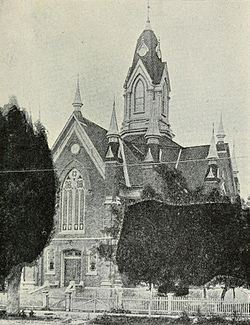Summit Stake Tabernacle | |
Formerly listed on the
U.S. National Register of Historic Places | |
 Photo published in 1914. | |
| Location | Stood at 1st North and Main Sts. Coalville, Utah |
|---|---|
| Coordinates | 40°55′2″N 111°23′56″W / 40.91722°N 111.39889°W |
| Built | 1899 |
| Architect | Thomas L. Allen |
| Architectural style | Gothic |
| NRHP reference No. | 71001078 |
| Significant dates | |
| Added to NRHP | 1971 [1] |
| Removed from NRHP | April 9, 1971 |
The Summit Stake Tabernacle or "Coalville Tabernacle" was a meetinghouse of the Church of Jesus Christ of Latter-day Saints (LDS Church) located in Coalville, Summit County, Utah.
Construction
Plans for the Summit Stake Tabernacle were made shortly after the creation of the Summit Stake in 1877, and the architect and builder was Thomas L. Allen. The cornerstone was laid by Franklin D. Richards on August 7, 1879. The construction of the tabernacle included 600,000 locally-made bricks, 75,000 feet of lumber (both Oregon red pine and local lumber from Echo Canyon), and sandstone from the Coalville ledge quarry. The unique gothic-style architecture included a 117-foot tower that was visible miles away. The interior had stained glass windows imported from Belgium and an elaborately-painted ceiling. The tabernacle was dedicated on May 14, 1899 by LDS Church President Lorenzo Snow. [2]
Renovation
In the 1940s, renovations took place to alter the interior of the tabernacle into a more functional meetinghouse with classrooms. However, in a short time, even these alterations were deemed inadequate and a new stake center was planned.
Demolition
After serving the Summit Stake and greater Coalville community for over 70 years, church administrators went through with plans to demolish the tabernacle. The building was listed on the Utah State Register of Historic Sites in 1970 and the National Register of Historic Places in 1971 shortly before demolition as attempts to preserve the building. [3] There were other attempts to preserve the building, including a group of residents that tried to place a restraining order on the church, which garnered much media attention, including reports from the New York Times. [4] However, two days after a judge struck down the restraining order, and amidst much controversy, church leaders removed some historically significant items from the tabernacle before bulldozers arrived. On March 5, 1971, the building was razed.
Allen Roberts reports that Milo Baughman, then the head of the Brigham Young University Department of Environmental Design, tried to organize a demonstration by students from the department against the demolition. The University blocked these plans, and soon closed the entire department. [5]
Notes
- ^ "National Register of Historic Places", NPS Focus, National Park Service, archived from the original on July 25, 2008, retrieved April 12, 2010
- ^ "Summit Stake Tabernacle p.10; 17248", Digital Public Library of America, November 7, 2006, archived from the original on October 21, 2015
- ^ Geary, Edward A. (Winter 1970), "The Last Days of the Coalville Tabernacle" (PDF), Dialogue: A Journal of Mormon Thought, 5 (4): 42–50, doi: 10.2307/45227697, JSTOR 45227697, S2CID 254394602, retrieved February 26, 2014
- ^ Fletcher Stack, Peggy (July 17, 2009), "Saving historic Mormon chapels", The Salt Lake Tribune, archived from the original on October 11, 2012, retrieved August 15, 2012
- ^ "'Mormon Land': Renovating Mormonism's 'Notre Dame' and preserving historic LDS buildings". The Salt Lake Tribune. April 17, 2019.
Further reading
- Anonymous (Winter 1970), "The Coalville Tabernacle: A Point of View" (PDF), Dialogue: A Journal of Mormon Thought, 5 (4): 50–58, doi: 10.2307/45227698, JSTOR 45227698, S2CID 254317298, retrieved February 26, 2014.
- Haggerty, John W. (1980). Historic Preservation in Utah, 1960-1980 (Thesis). Brigham Young University. Retrieved February 26, 2014..
- Leone, Mark P. (Summer 1973), "Why the Coalville Tabernacle had to be Razed" (PDF), Dialogue: A Journal of Mormon Thought, 8 (2): 30–39, doi: 10.2307/45224399, JSTOR 45224399, S2CID 254397318, retrieved February 26, 2014.
- Salisbury, Paul G. (Winter 1970), "The Lesson of Coalville" (PDF), Dialogue: A Journal of Mormon Thought, 5 (4): 58–65, doi: 10.2307/45227699, JSTOR 45227699, S2CID 254388999, retrieved February 26, 2014.
- Smith, Bernett Blonquist (1967), History of Summit Stake Tabernacle, OCLC 122653633.
- Wood, Thomas; Hill, Douglas (Summer 1967), "The Coalville Tabernacle: A Photographic Essay" (PDF), Dialogue: A Journal of Mormon Thought, 2 (2): 63–74, doi: 10.2307/45223887, JSTOR 45223887, S2CID 254403106, retrieved February 26, 2014.
- 19th-century Latter Day Saint church buildings
- Buildings and structures in Summit County, Utah
- Demolished churches in the United States
- Former churches in Utah
- Former Latter Day Saint religious buildings and structures
- Churches completed in 1899
- Tabernacles (LDS Church) in Utah
- Buildings and structures demolished in 1971
- Demolished buildings and structures in Utah
- Former National Register of Historic Places in Utah
